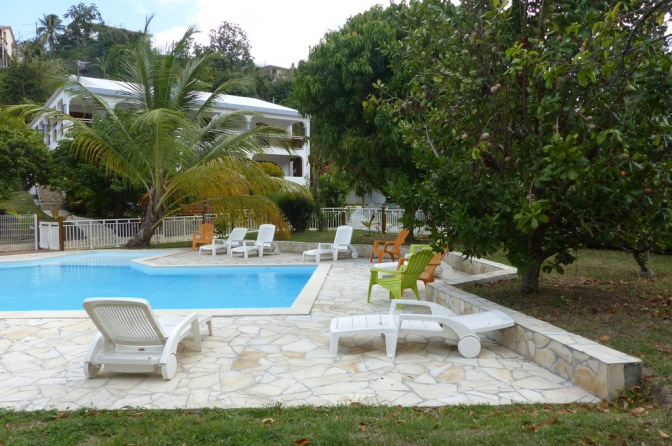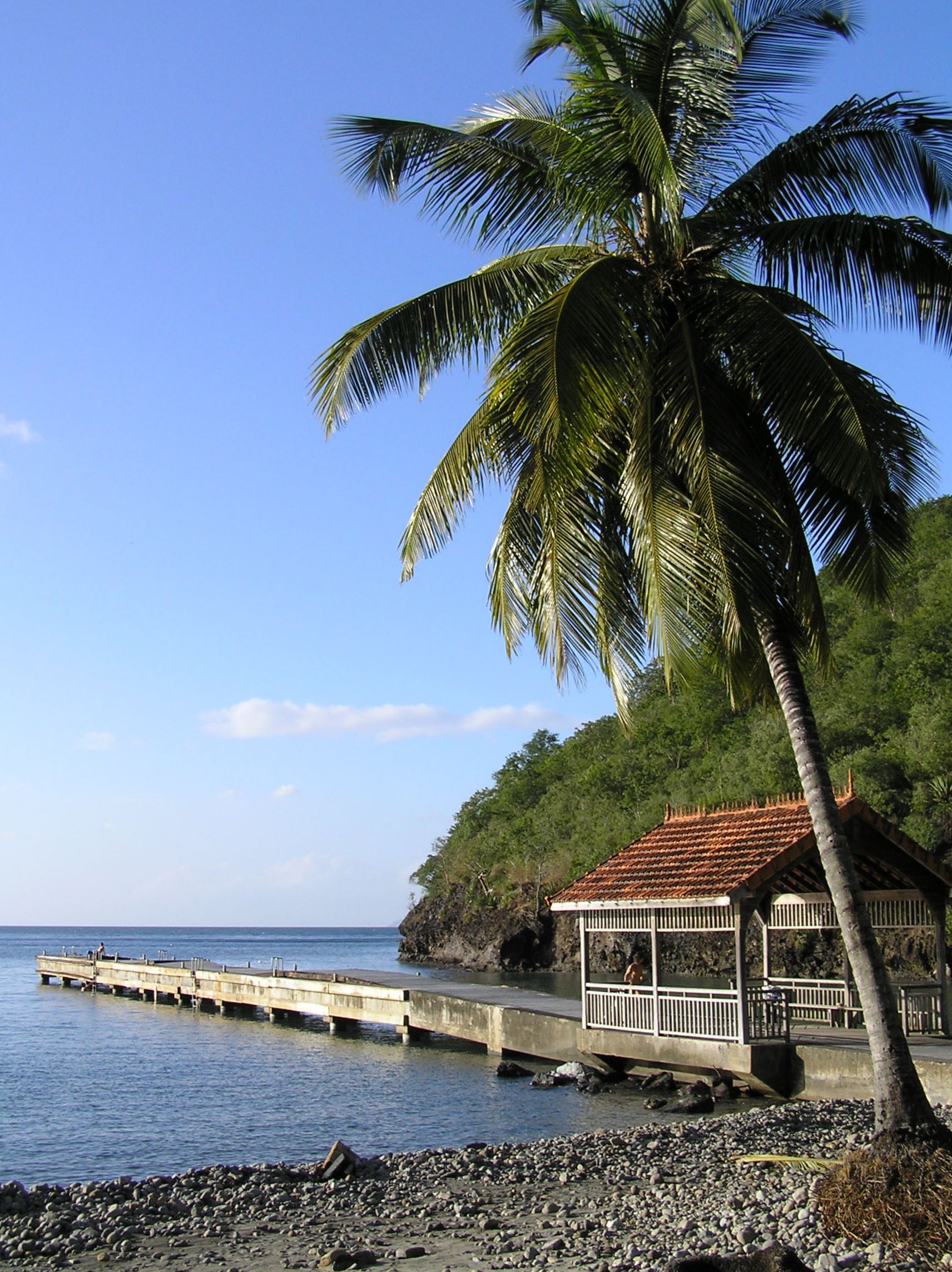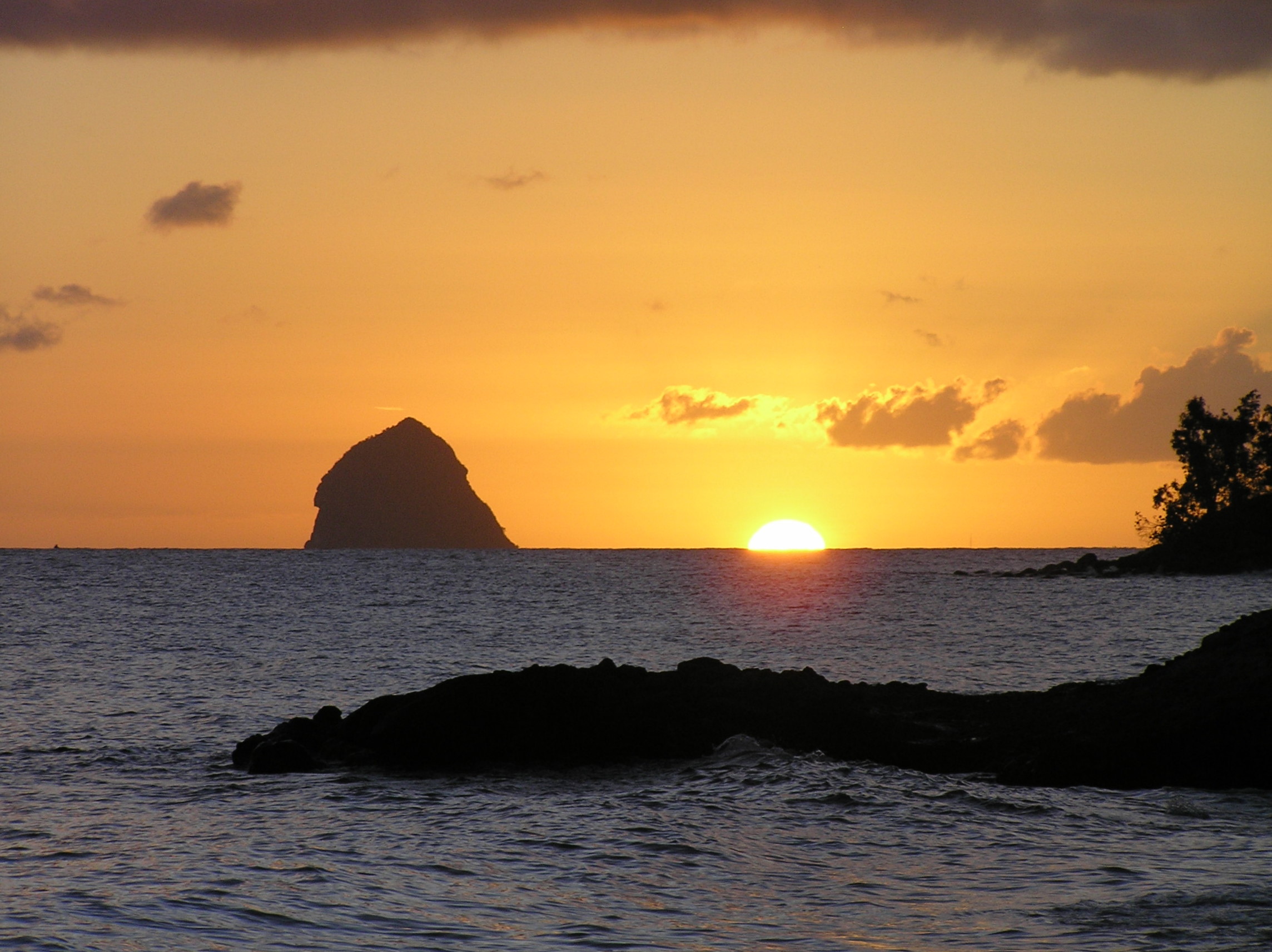Our partners
Habitation Diamant
For your convenience, we have created our own range of accommodation.
We offer 5 flats, for 2 to 8 people, in a house set in the heart of a tropical garden with swimming pool and private car park.
And on each flat terrace, you’ll find a Spa at your disposal!
Habitation Diamant
Rue Osman Durand
97223 Le Diamant
06 96 81 93 42
Rentîles
Rentîles Airport pickup or delivery anywhere on the island Booking: 04 83 50 11 75 contact@rentiles.fr
Habitation Diamant
Alpha Plongée Martinique is a partner of the Clément foundation and rum distillery. You can take advantage of special rates to visit this vast estate with its magnificent garden and the Clément Foundation.
Habitation Clément
Domaine de l’Acajou
Le François 97240
+596 596 54 62 07
Practical Advices
OUR TROPICAL CLIMATE
There are two seasons in Martinique: the dry season from December to May and the wet season from June to November. The latter is not very marked and it is therefore very pleasant to come to Martinique all year round.
Visiting our island in certain months of the wet season is even very advantageous because plane tickets are cheaper and there are fewer people on the island!
If you choose to come in May and June, it hardly rains, the temperatures are warm (air and water) and there is no wind: ideal weather for diving! </ p >
The weather does not affect the quality of the water when diving. As we do not have a river that flows into the sea at Anses D’Arlet, the water never becomes cloudy and we maintain our visibility of 40 meters all year round.
In diving, the maximum temperatures are observed in July-August with 30°C at the hottest. In December-January we record temperatures around 26°C: it’s a little cooler!
This is why in the center, we offer 4mm shorty wetsuits, but also 3mm long wetsuits that keep you cool in the dry season.
YOUR HEALTH
There is no vaccine or anti-malaria treatment needed to come to this tropical area. This doesn’t mean that we don’t have mosquitoes. Little present during the day, our friends make their appearance at nightfall. For the evening, plan on long clothes and mosquito repellent. If you don’t want to be too hassle, choose a rental that is high and airy. In the evening before going to bed, lightly air-condition your room to cool it down. Even if the perceived outside temperature is not the same depending on the season, there is one constant: the sun! You have to think about protecting yourself. Sunscreen is essential. For diving, we recommend a hat and sunglasses because on the boat we are close to the surface of the water and there is reverberation. Also, when you are snorkeling and don’t have a boyshort, consider putting on a t-shirt.
LIFE ON THE ISLAND
As in Metropolitan France, electricity is 220 volts, water is running and potable and the currency used is the euro. We are in the same time zone as New York City on the East Coast of the United States. When the Metropolis is in winter time, we have a 5 hour shift and when it is summer time, we have a 6 hour shift. For us, little difference throughout the year on the sunrise and the coachman. It is daylight around 6:00 a.m. and the sun sets around 6:00 p.m. This leaves you 12 noon to visit our island: to get around, we advise you to rent a car. The distances do not seem important but the roads are winding! And to fully enjoy the scenery, in addition to the swimsuit and flip-flops, consider putting a pair of walking shoes in the suitcase.
Martinique from below
Discover Martinique and life on the reefs
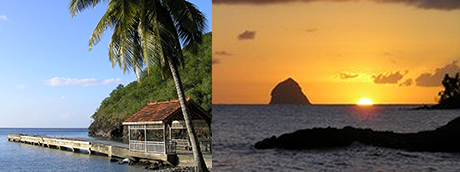
The Caribbean Sea
Welcome to the Caribbean Sea: clear water all year round, ranging from 26°C (Christmas) to 30°C (July-August).
Let’s set off to discover Martinique on the island’s south-west coast, at Grande Anse d’Arlet, where there is no coral reef. We dive directly into the Caribbean Sea, which offers us a wide variety of relief and depths, all accessible from our anchorages along the coast.
Martinique’s reefs, particularly those at Grande Anse, are rich and colourful. An abundance of fauna roams our reefs, which are made up of coral and especially sponges, animals with the simplest of lifestyles underwater.
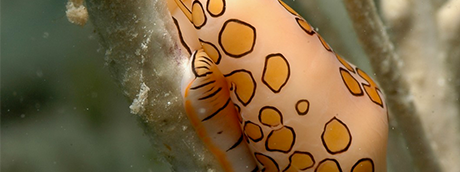
Molluscs
Molluscs are soft-bodied animals. They are well known to gourmets and food lovers because they are the stuff of life on our plates. Oysters, mussels, scallops and octopus are all molluscs. In Martinique, you’ll find octopus in the traditional dish called ‘Chatrou’.
Many molluscs protect their bodies with a shell, like the lambis we sometimes see diving at Grande Anse.
Almost all molluscs are mobile. Some, like the mother-of-pearl, are barely mobile, while others, like the squid, are among the fastest marine animals (they can travel at speeds of up to 20 knots)!

Worms
Annelid worms are made up of several ring-shaped segments (hence their name).
There are also mobile worms such as the fire worm. They feed on cnidarians. Beware, as its name suggests, it “burns” its attackers.
There are also sedentary worms. They are fixed and live in tubes. You can see their plumes, which they use to filter the water. At the slightest alarm, they retract their plumes into their tubes, as is the case with the Spirographe or the Christmas Tree Spirobranchs, which can be found nestling in the brain corals of Grande Anse d’Arlet.
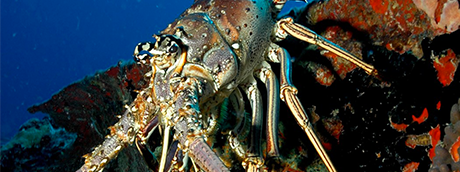
Crustaceans
Crustaceans are animals with a rigid, jointed skeleton. As well as the best-known crustaceans such as prawns, crabs, lobsters and crayfish, there are many planktonic species. In all, there could be around 50,000 species of crustacean.
In Martinique, the most popular arthropod (in restaurants) is, of course, the lobster, whose moults we often see while diving.
This is because crustaceans have a shell that they have to replace as they grow: they moult. While waiting for its new shell to harden (around 24 hours), the crustacean is very vulnerable to predators.
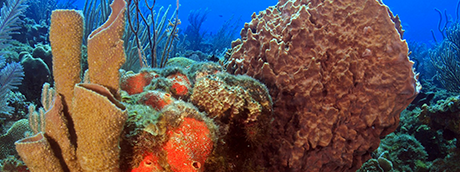
Sponges
Sponges are found in all seas and at all depths. They are the richness of the Caribbean Sea, which borders Grande Anse d’Arlet in the south of Martinique. Yellow, green, blue, pink, purple… there’s no doubt: it’s sponges that give it such pretty colours!
Sponges are always attached. They filter the water to remove the oxygen and micro-organisms it contains.
They have another special feature: spongin. This is the highly elastic material we call sponge, which has been used since Antiquity for washing!
Sponges vary greatly in size. Some are just a few centimetres long, while Martinique barrel sponges can grow to 2 metres. They grow at a rate of 2cm a year, which means they are over a hundred years old!
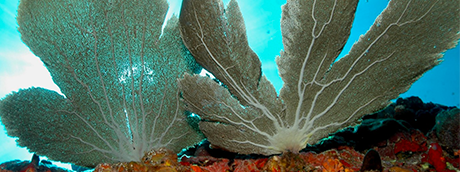
Cnidarians
They are stinging animals: cnidaria comes from the Greek knidê, which means nettle! They are widespread in the Caribbean Sea, especially in Grande Anse d’Arlet (corals are part of this phylum). They are characterised by a mouth surrounded by tentacles. These tentacles contain stinging cells called cnidocysts. They are both a means of protection and a means of feeding.
In Martinique, although most cnidarians are harmless to humans, some can be particularly stinging, such as fire coral and certain jellyfish.
This phylum is rich and diverse: some cnidarians are pelagic (jellyfish), some are benthic (corals), some live alone (anemones) and others live in colonies (corals, gorgonians).
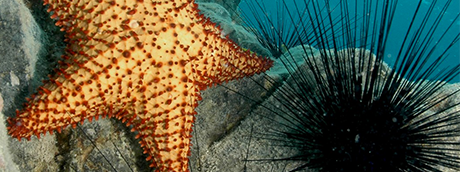
Echinoderms
They are stinging animals: cnidaria comes from the Greek knidê, which means nettle! They are widespread in the Caribbean Sea, especially in Grande Anse d’Arlet (corals are part of this phylum). They are characterised by a mouth surrounded by tentacles. These tentacles contain stinging cells called cnidocysts. They are both a means of protection and a means of feeding.
In Martinique, although most cnidarians are harmless to humans, some can be particularly stinging, such as fire coral and certain jellyfish.
This phylum is rich and diverse: some cnidarians are pelagic (jellyfish), some are benthic (corals), some live alone (anemones) and others live in colonies (corals, gorgonians).
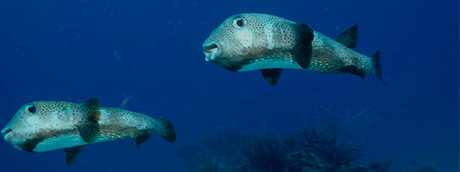
Vertebrates
In the vertebrate phylum, we come across reptiles (turtles), mammals (whales and dolphins) and, of course, fish. In Martinique, we see whales from January to March. Turtles can be seen every day on the beach at Grande Anse d’Arlet.
There are two main categories of fish: bony fish and cartilaginous fish (unlike the former, their skeletons are not made of bone, so they are very flexible: sharks and rays). Fish account for just 5% of all animal species…
A very special inhabitant of the Grande Anse reefs: the Diodon Porc-Epic, which is of course a bony fish. When frightened, it swallows a large quantity of water and inflates a pouch close to its stomach. By doubling in size and bristling with the spines that cover it, it tries to frighten off its predators. Some parts of its skeleton are even missing so as not to interfere with the expansion.
Martinique from above
Discover Martinique and life on the island
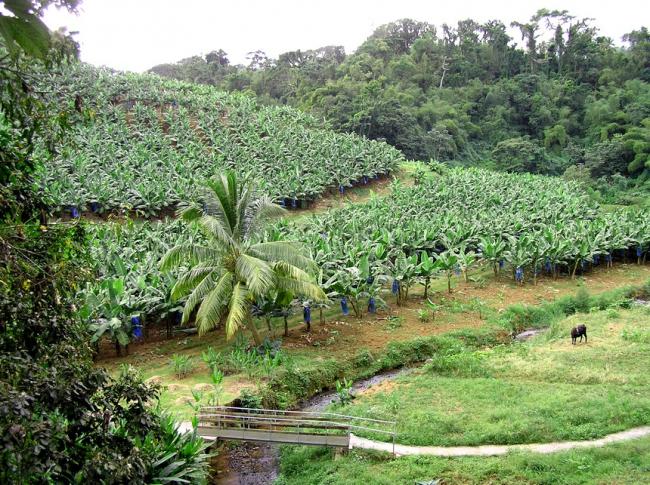
Bananas
We never dive on an empty stomach! So why not enjoy a small banana before joining us at Alpha Plongée.
Native to Asia, the banana tree is a plant that is often thought of as a tree. It is a symbol of the tropical world and of Martinique. There are more than fifty species.
Some bananas are “cooking bananas” (vegetables), others are “eating bananas” (desserts). Some bananas have very evocative names for their size: “Get dressed, young man”, “God forbid”, etc.

The Carnival
It’s a funny outfit to wear as a diver. Put on your wetsuit and get dressed up for your dive!
If, in addition to your dive, you feel like parading around, head to Martinique in February for Carnival. Discovering Martinique also means discovering Carnival. It begins on the Sunday after Epiphany and ends on Ash Wednesday. Each day of the Carnival is different: Sunday is the day of the multicoloured parade, Monday is the day of the burlesque weddings (men dress up as women and women as men), Tuesday is the day of the devils (the colour of the disguises will therefore be red), and on Ash Wednesday, everyone will dress up in black and white to attend the funeral of Vaval (the king of the party). Carnival is an important time of year that every Martinican loves to celebrate.
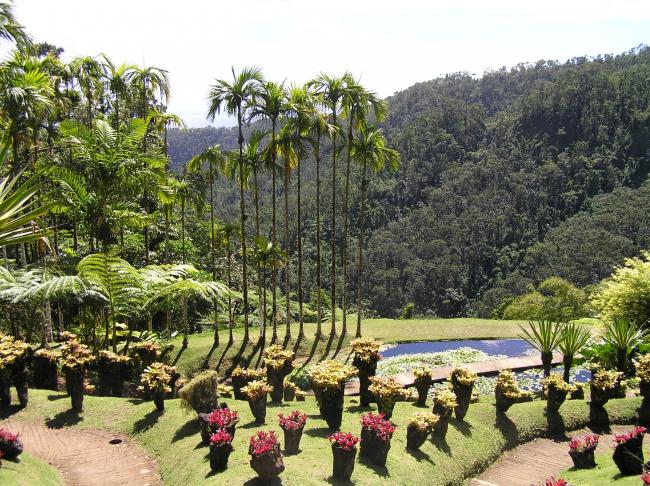
The Flower Island
During your dives, you’ll see almost exclusively animals. For plants, head for land.
Martinique is also known as Madinina, “the island of flowers”, because it has such a wide variety (more than 1,700 species have been recorded, not counting everything that man has introduced himself over time).
Flowers, plants, trees: the rich soil and tropical climate are conducive to luxuriant, highly diversified vegetation. In fact, in Martinique, it rains eight times more at the top of Mount Pelée than in Saint Anne. (Photo of Jardin de Balata)
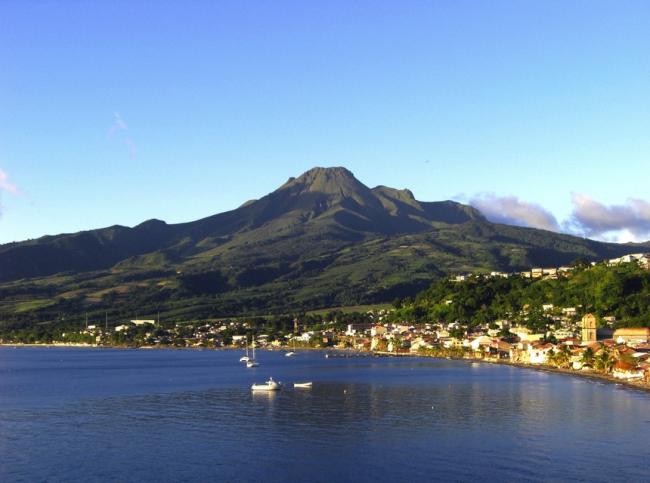
A volcanic island
Throughout your dives, you’ll discover reefs that are highly diverse but always rugged, undoubtedly the result of major volcanic activity.
Twelve volcanoes have contributed to the formation of Martinique. Montagne Pelée is the youngest of them all. Montagne Pelée does not owe its name to its sparse vegetation, since in the 19th century it was covered by a dense forest of palm trees and tree ferns. Its name comes from the Caribbean Indians, who settled at the foot of the volcano, spoke of the mountain of fire and worshipped their Fire Goddess: the Pele Goddess. When this very touchy goddess was angry, she would strike the ground with her foot, causing earthquakes and volcanic eruptions.

Lobsters
Sought after by divers and gourmets alike, this spiny shellfish with its long antennae can be found in almost every restaurant in Grande Anse d’Arlet.
After a good dive on our reefs, the lobster will delight your taste buds and its price in Martinique will make you want to try it again. In Martinique, lobster has long been considered the dish of the poor. It was eaten for want of anything better when there was no fish. You’d buy fish and the fisherman would offer you lobsters… it’s a dream come true.
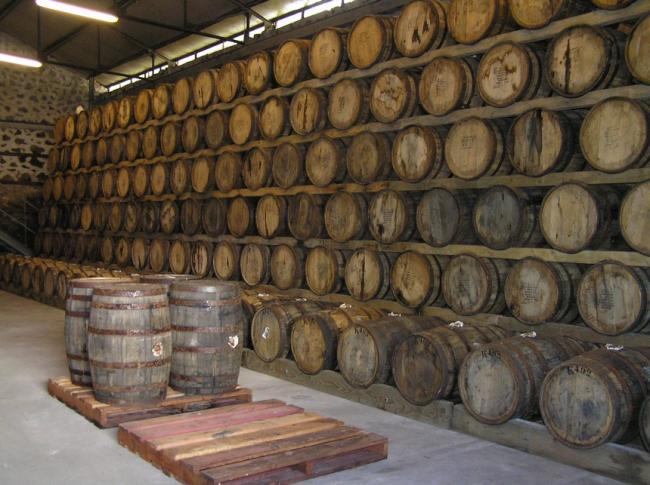
Rum
A dive at Alpha Plongée always ends with a planteur, to share your underwater adventures. And in the planteur, there is of course rum, the essential drink in Martinique.
There are two types of rum. Industrial rums are obtained by distilling the residue from sugar production: molasses, and agricultural rums, produced in the French West Indies, are made from the first juice of the cane: vesou. Since 1996, Martinique’s agricultural rums have benefited from the Appellation Origine Contrôlée. The reputation of Martinique rums has grown ever since. The island’s aged rums are among the best in the world! (Photo Rhum Clément)

The Turtles
You’ve been dreaming about them… they’re here! During your stay in Martinique, you’re sure to come across this endangered species: sea turtles.
Green turtles can be seen all year round in Martinique’s waters. They can measure over a metre in length and weigh more than 100 kg. You’re sure to spot them while snorkelling in front of our diving club. The bay of Grande Anse is in fact a huge seagrass bed, making it a favourite haunt for green turtles, which feed mainly on phanerogamous seagrass beds.
While diving, you may also come across hawksbill turtles (measuring around one metre and weighing an average of 70 kg). Hawksbill turtles feed on sponges, crustaceans and molluscs living around corals. Another turtle also visits us in Martinique. It averages 1.50 metres in length and weighs 500 kg. But it is above all a pelagic animal (living in deep waters) and can dive to depths of over 1,000 metres. Enough to make any diver swoon! It is, of course, the leatherback turtle. From March to July, the leatherback turtle comes to Grande Anse to lay its eggs on the beach.
Sea turtles are on the International Union for Conservation of Nature’s Red List. They are considered to be in critical danger of extinction. So let’s protect them! (our turtle story)
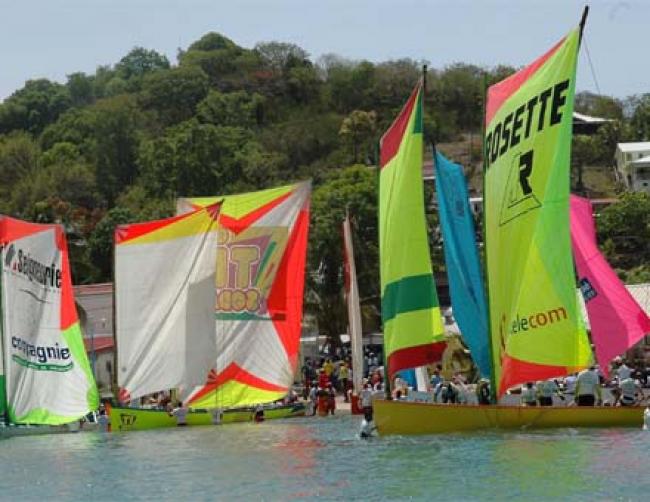
The Yawl Race
Our boat is a yawl: the traditional boat of the fishermen of Anses d’Arlet. Fitted with sails, it becomes a competition boat. In Martinique, in August, you can’t miss the Tour des yoles.
The sailing yawl is a ten-metre boat with no keel and one or two rectangular sails.
The crew have to hang on to the oars outside the boat to prevent the yawl from capsizing. The event was created in 1985 and quickly became a huge success. It’s one of Martinique’s biggest celebrations, on a par with the carnival.
Where to find us?
Our Alpha Plongée center is located on the beach of Grande Anse d’Arlet, about 200m to the right of the pontoon, looking out to sea. We are in the middle of the pedestrian street which runs along the seaside, between the restaurants ” Bidjoul ”and“ Les Arcades ”.
If you decide to join us by car, you can park in the large car park which overlooks the road opposite the grocery store. It is indicated by a large blue sign. To find us, all you have to do is cross the road and slip between two rows of houses.
Alpha Plongée Martinique
97217 LES ANSES D’ARLET.

